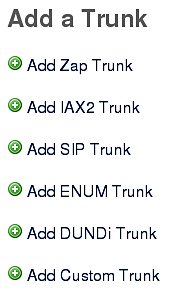A trunk in the simplest of terms is a pathway into or out of a telephone system. A trunk connects a PBX to outside resources, such as PSTN telephone lines, or additional PBX systems to perform inter-system transfers. Trunks can be physical, such as a PRI or PSTN line, or they can be virtual by routing calls to another endpoint using Internet Protocol (IP) links.
Trunk types
FreePBX allows the creation of six different types of trunks as follows:
- Zap
- IAX2
- SIP
- ENUM
- DUNDi
- Custom
Zap, IAX2, and SIP trunks utilize the technologies of their namesake. These trunks have the same highlights and pitfalls that extensions and devices using the same technology do. Zap trunks require physical hardware cards for incoming lines to plug into. SIP trunks are the most widely adopted and compatible, but have difficulties traversing firewalls. IAX2 trunks are able to traverse most firewalls easily, but are limited to adoption mainly on Asterisk-based systems.
In terms of VoIP, ENUM(E.164 NUmber Mapping) is a method for unifying E.164 (the international telecommunication numbering plan) with VoIP routing. The ENUM system can be considered very similar to the way that the Internet DNS system works. In the DNS system, when a domain name is looked up an IP address is returned. The IP address allows a PC to traverse the Internet and find the server that belongs to that IP address. The ENUM system provides VoIP routes back when queried for a phone number. The route that is returned is usually a SIP or IAX2 route.
An ENUM trunk allows FreePBX to send the dialed phone number to the publice164.orgENUM server. If the called party has listed their phone number in the e164.org directory, a VoIP route will be returned and the call will be connected using that route. A VoIP route contains the VoIP protocol, the server name or IP address, the port, and the extension to use in order to contact the dialed phone number. For example, a SIP route for dialing the number 555-555-1234 might appear as SIP:1234@pbx.example.com:5060. This is advantageous in several ways. It is important to note that indirect routes to another telephony system are often costly. Calling a PSTN telephone number typically requires that call to route through a third-party provider's phone lines and switching equipment (a service they will happily charge for). If a number is listed in the ENUM directory, the returned route will bridge the call directly to the called party (or their provider), bypassing the cost of routing through a third party.
ENUM also benefits the called party, allowing them to redirect inbound calls to wherever they would like. Service disruptions that would otherwise render a particular phone number useless can be bypassed by directing the phone number to a different VoIP route in the ENUM system.
More information on ENUM can be found at the following web sites:
DUNDi (Distributed Universal Number Discovery) is a routing protocol technology similar to ENUM. In order to query another Asterisk system using DUNDi, that system must be "peered" with your own Asterisk system. Peering requires generating and exchanging key files with the other peer.
DUNDi is a decentralized way of accomplishing ENUM-style lookups. By peering with one system you are effectively peering with any other system that your peer is connected to. If system A peers with system B, and system B peers with system C, then system C will be able to see the routes provided by system A. In peer-topeer fashion, system B will simply pass the request along to system A, even though system C has no direct connection to system A.
DUNDi is not limited to E.164 numbering schemes like ENUM and it allows a PBX to advertise individual extensions, or route patterns, instead of whole phone numbers. Therefore, it is a good candidate for distributed office setups, where a central PBX can be peered with several satellite PBX systems. The extensions on each system will be able to call one another directly without having to statically set up routes on each individual PBX.
Unlock access to the largest independent learning library in Tech for FREE!
Get unlimited access to 7500+ expert-authored eBooks and video courses covering every tech area you can think of.
Renews at $19.99/month. Cancel anytime
More information on DUNDi can be found at the following web sites:
Custom trunks work in the same fashion as custom extensions do. Any valid Asterisk Dial command can be used as a custom trunk by FreePBX. Custom trunks typically use additional VoIP protocols such as H.323 and MGCP.
Setting up a new trunk
Setting up a trunk in FreePBX is very similar to setting up an extension. All of the trunks share eight common setup fields, followed by fields that are specific to the technology that trunk will be using.
In order to begin setting up a trunk, click on Trunks in the left side navigation menu as shown in the following screenshot:

From the Add a Trunk screen, click on the name of the technology that the trunk will be using (for example, if a SIP trunk will be used, click on Add SIP Trunk) as shown in the following screenshot:

 United States
United States
 Great Britain
Great Britain
 India
India
 Germany
Germany
 France
France
 Canada
Canada
 Russia
Russia
 Spain
Spain
 Brazil
Brazil
 Australia
Australia
 Singapore
Singapore
 Canary Islands
Canary Islands
 Hungary
Hungary
 Ukraine
Ukraine
 Luxembourg
Luxembourg
 Estonia
Estonia
 Lithuania
Lithuania
 South Korea
South Korea
 Turkey
Turkey
 Switzerland
Switzerland
 Colombia
Colombia
 Taiwan
Taiwan
 Chile
Chile
 Norway
Norway
 Ecuador
Ecuador
 Indonesia
Indonesia
 New Zealand
New Zealand
 Cyprus
Cyprus
 Denmark
Denmark
 Finland
Finland
 Poland
Poland
 Malta
Malta
 Czechia
Czechia
 Austria
Austria
 Sweden
Sweden
 Italy
Italy
 Egypt
Egypt
 Belgium
Belgium
 Portugal
Portugal
 Slovenia
Slovenia
 Ireland
Ireland
 Romania
Romania
 Greece
Greece
 Argentina
Argentina
 Netherlands
Netherlands
 Bulgaria
Bulgaria
 Latvia
Latvia
 South Africa
South Africa
 Malaysia
Malaysia
 Japan
Japan
 Slovakia
Slovakia
 Philippines
Philippines
 Mexico
Mexico
 Thailand
Thailand
















